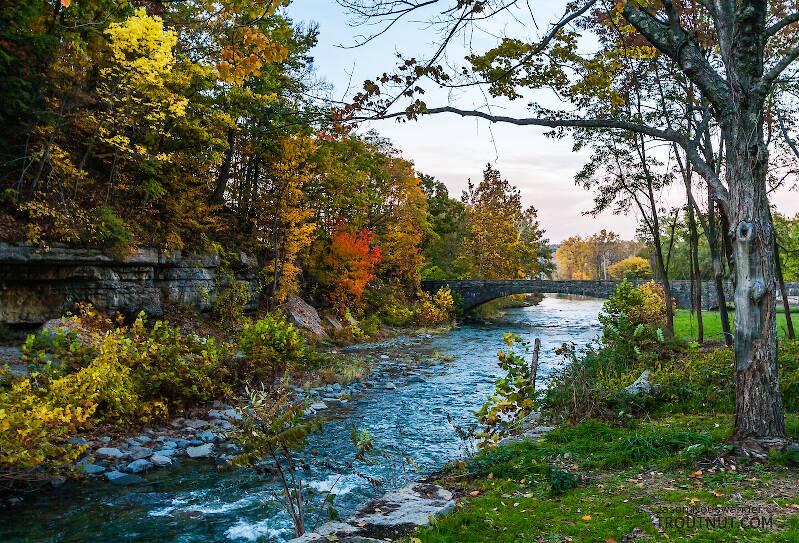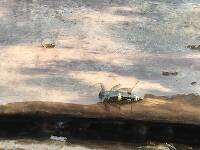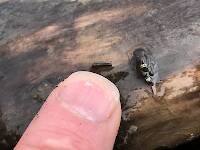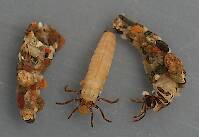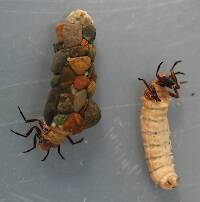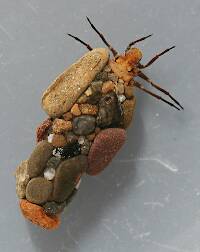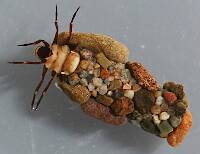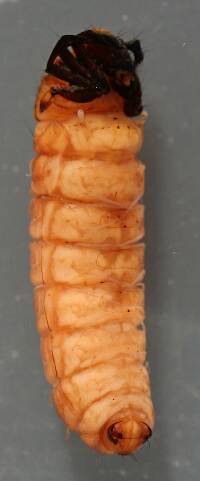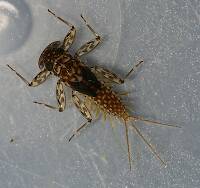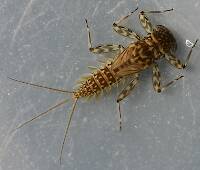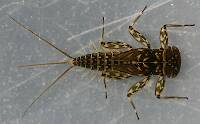
Blue-winged Olives
Baetis
Tiny Baetis mayflies are perhaps the most commonly encountered and imitated by anglers on all American trout streams due to their great abundance, widespread distribution, and trout-friendly emergence habits.
Featured on the forum

It's only barely visible in one of my pictures, but I confirmed under the microscope that this one has a prosternal horn and the antennae are mid-way between the eyes and front of the head capsule.
I'm calling this one Pycnopsyche, but it's a bit perplexing. It seems to key definitively to at least Couplet 8 of the Key to Genera of Limnephilidae Larvae. That narrows it down to three genera, and the case seems wrong for the other two. The case looks right for Pycnopsyche, and it fits one of the key characteristics: "Abdominal sternum II without chloride epithelium and abdominal segment IX with only single seta on each side of dorsal sclerite." However, the characteristic "metanotal sa1 sclerites not fused, although often contiguous" does not seem to fit well. Those sclerites sure look fused to me, although I can make out a thin groove in the touching halves in the anterior half under the microscope. Perhaps this is a regional variation.
The only species of Pycnopsyche documented in Washington state is Pycnopsyche guttifera, and the colors and markings around the head of this specimen seem to match very well a specimen of that species from Massachusetts on Bugguide. So I am placing it in that species for now.
Whatever species this is, I photographed another specimen of seemingly the same species from the same spot a couple months later.
I'm calling this one Pycnopsyche, but it's a bit perplexing. It seems to key definitively to at least Couplet 8 of the Key to Genera of Limnephilidae Larvae. That narrows it down to three genera, and the case seems wrong for the other two. The case looks right for Pycnopsyche, and it fits one of the key characteristics: "Abdominal sternum II without chloride epithelium and abdominal segment IX with only single seta on each side of dorsal sclerite." However, the characteristic "metanotal sa1 sclerites not fused, although often contiguous" does not seem to fit well. Those sclerites sure look fused to me, although I can make out a thin groove in the touching halves in the anterior half under the microscope. Perhaps this is a regional variation.
The only species of Pycnopsyche documented in Washington state is Pycnopsyche guttifera, and the colors and markings around the head of this specimen seem to match very well a specimen of that species from Massachusetts on Bugguide. So I am placing it in that species for now.
Whatever species this is, I photographed another specimen of seemingly the same species from the same spot a couple months later.

Troutnut is a project started in 2003 by salmonid ecologist Jason "Troutnut" Neuswanger to help anglers and
fly tyers unabashedly embrace the entomological side of the sport. Learn more about Troutnut or
support the project for an enhanced experience here.
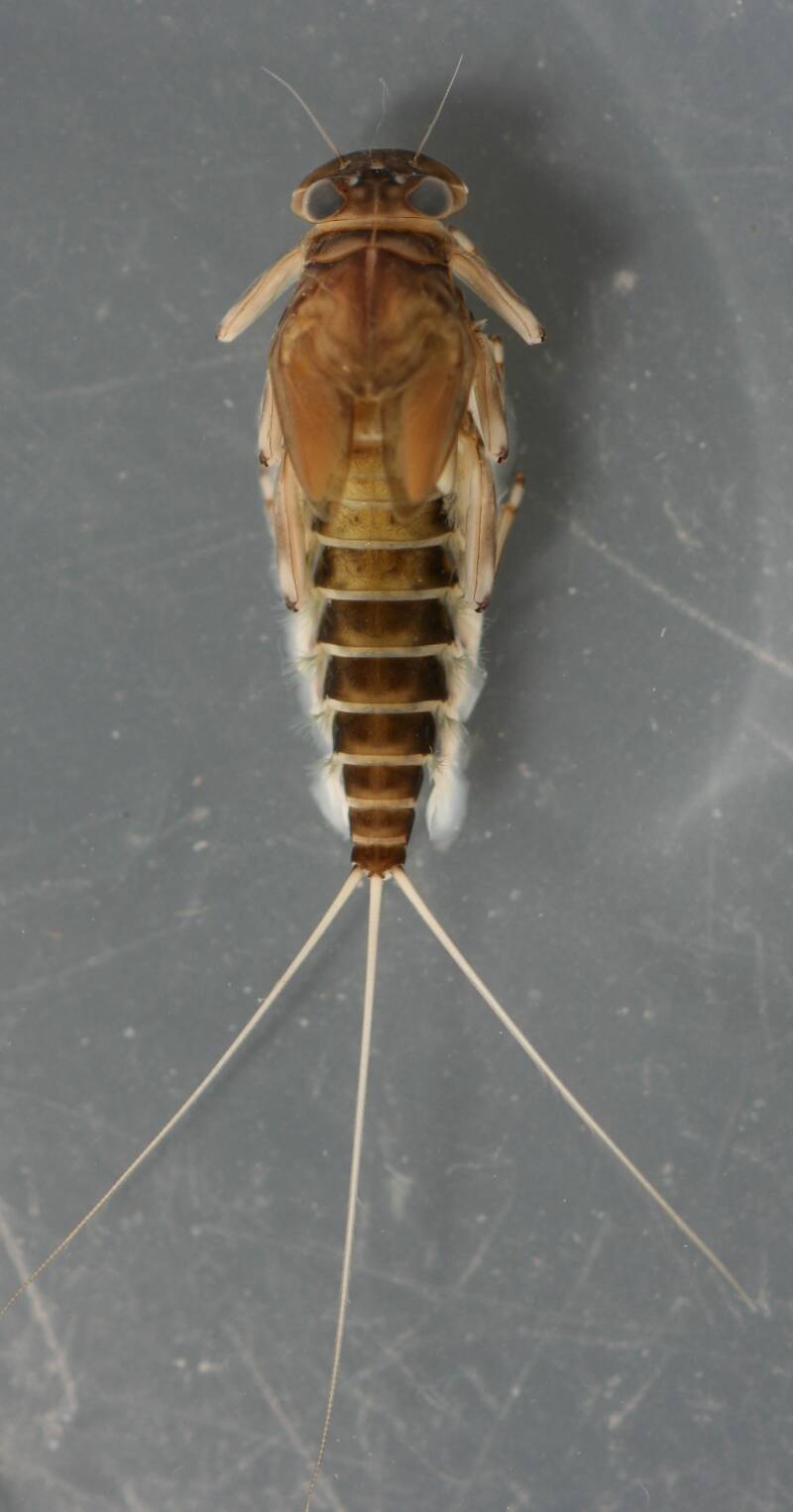
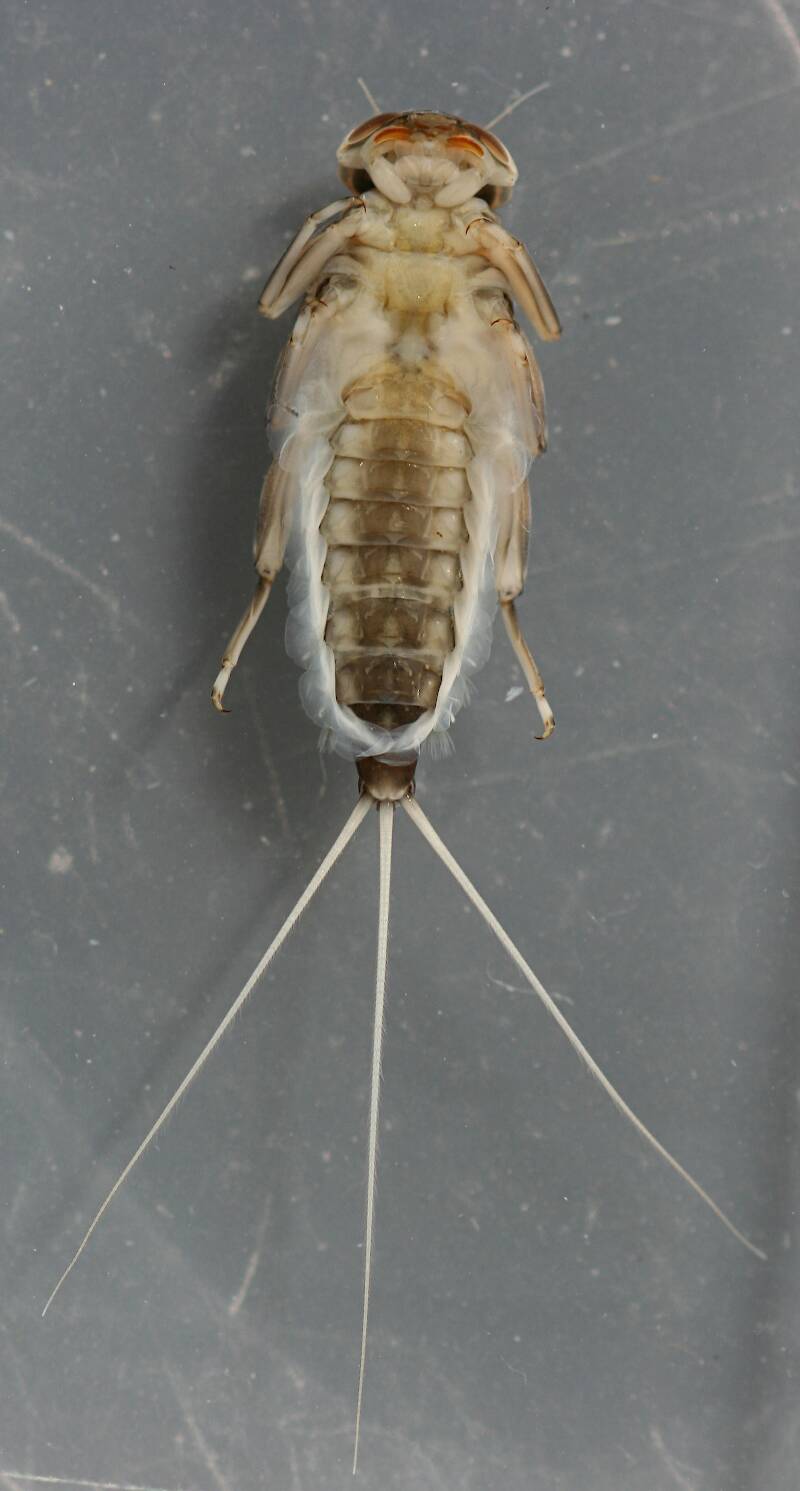
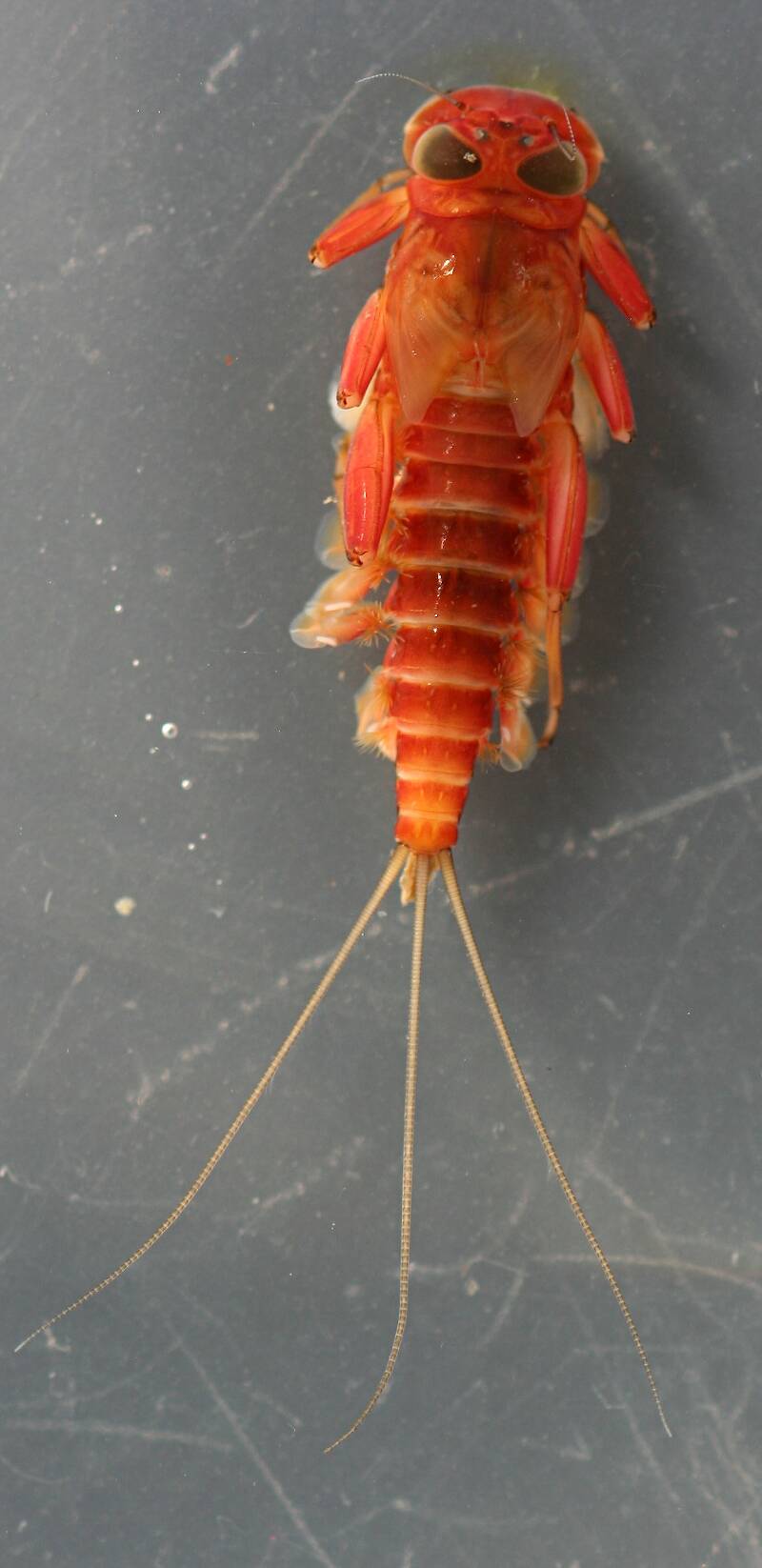
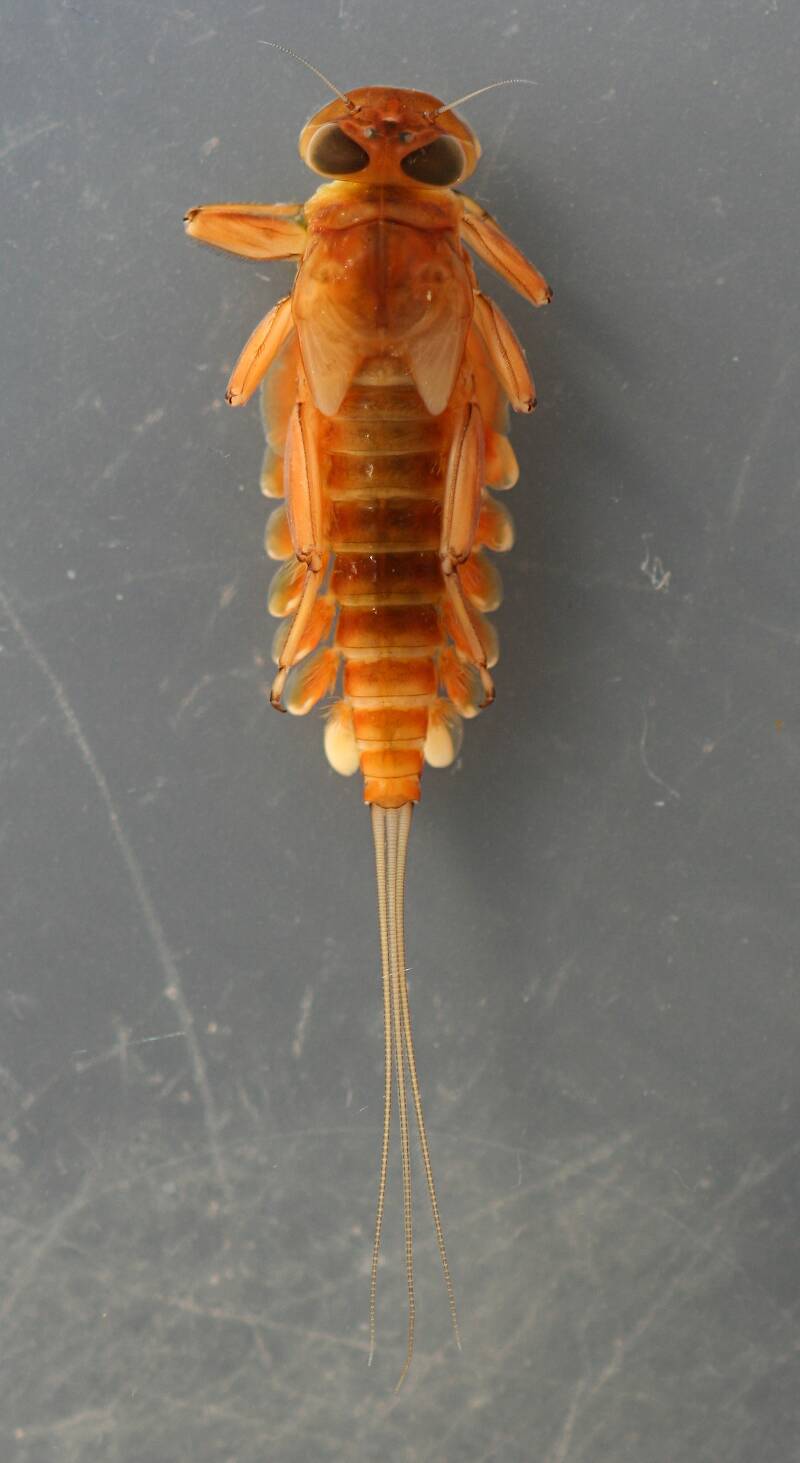

Millcreek on Jan 7, 2015January 7th, 2015, 6:19 pm EST
These are photos of a Rhithrogena nymph from the Russian River. They are also found in Mill Creek, a tributary to the Russian River. They are typically in the river and creeks from February until April. The mature ones are from 12-14 mm long (excluding cerci and antennae). I'd like to find the species if possible. The red ones make up about 5% of the population and appear to be the same species as the brown ones.
"If we knew what it was we were doing, it would not be called research, would it?"
-Albert Einstein
-Albert Einstein
Taxon on Jan 7, 2015January 7th, 2015, 10:38 pm EST
Hi Mark-
I believe the red ones to be Rhithrogena robusta, and the brown ones to be Rhithrogena morrisoni.
I believe the red ones to be Rhithrogena robusta, and the brown ones to be Rhithrogena morrisoni.
Millcreek on Jan 8, 2015January 8th, 2015, 5:16 am EST
Roger,
What do you base your supposition on? Is there a paper or did you get there through personal experience? Just curious.
I believe the red ones to be Rhithrogena robusta, and the brown ones to be Rhithrogena morrisoni.
What do you base your supposition on? Is there a paper or did you get there through personal experience? Just curious.
"If we knew what it was we were doing, it would not be called research, would it?"
-Albert Einstein
-Albert Einstein
Taxon on Jan 8, 2015January 8th, 2015, 7:45 am EST
Hi Mark-
My supposition is based on several factors.
Mayflies (Ephemeroptera) of the Far Western United States. Part 3: California, by Meyer and McCafferty, 2008, lists mayfly distribution by county. So, I printed (7) copies of the CA Counties map (which was also in the paper) in order to mark the county distribution of each of the (7) Rhithrogena species listed for CA.
R. decora is only recorded in (3) E. CA counties
R. flavianula is only recorded in (5) E. CA counties
R. hageni is widely distributed throughout the state, and is recorded in Mendocino Co., but not in Sonoma Co.
R. morrisoni is widely distributed throughout the state, and is recorded in Sonoma Co.
R. plana is only recorded in (1) E. CA county
R. robusta is mostly recorded in E. CA counties, but is also recorded in several W. CA counties, the closest to Sonoma Co. being Colusa Co.
R. undulata is not recorded as being present in a county anywhere near Sonoma Co.
So I believe R. hageni, R. morrisoni, and R. robusta to be the only likely candidates. In that R. hageni is not recorded in Sonoma Co., and R. morrisoni is recorded in Sonoma Co., I believe that R. morrisoni is more likely to be the species of your brown ones.
And, in that Rhithrogena robusta is reported to have red gills, I believe that it is most likely candidate to be the species of your red ones.
In any event, and for better or worse, that is the basis for my supposition.
My supposition is based on several factors.
Mayflies (Ephemeroptera) of the Far Western United States. Part 3: California, by Meyer and McCafferty, 2008, lists mayfly distribution by county. So, I printed (7) copies of the CA Counties map (which was also in the paper) in order to mark the county distribution of each of the (7) Rhithrogena species listed for CA.
R. decora is only recorded in (3) E. CA counties
R. flavianula is only recorded in (5) E. CA counties
R. hageni is widely distributed throughout the state, and is recorded in Mendocino Co., but not in Sonoma Co.
R. morrisoni is widely distributed throughout the state, and is recorded in Sonoma Co.
R. plana is only recorded in (1) E. CA county
R. robusta is mostly recorded in E. CA counties, but is also recorded in several W. CA counties, the closest to Sonoma Co. being Colusa Co.
R. undulata is not recorded as being present in a county anywhere near Sonoma Co.
So I believe R. hageni, R. morrisoni, and R. robusta to be the only likely candidates. In that R. hageni is not recorded in Sonoma Co., and R. morrisoni is recorded in Sonoma Co., I believe that R. morrisoni is more likely to be the species of your brown ones.
And, in that Rhithrogena robusta is reported to have red gills, I believe that it is most likely candidate to be the species of your red ones.
In any event, and for better or worse, that is the basis for my supposition.
Millcreek on Jan 8, 2015January 8th, 2015, 10:29 am EST
Roger,
I agree with the R. morrisoni assessment and your R. robusta is likely to be correct except for one thing. R. morrisoni has a red version that is detailed in Day's paper on "The California Mayflies of the Genus Rhithrogena (Ephemeroptera)". http://www.ephemeroptera-galactica.com/pubs/pub_d/pubdayw1957p1.pdf
I believe it to be the red version of R.morrisoni that is the other nymph here.
Mark
I agree with the R. morrisoni assessment and your R. robusta is likely to be correct except for one thing. R. morrisoni has a red version that is detailed in Day's paper on "The California Mayflies of the Genus Rhithrogena (Ephemeroptera)". http://www.ephemeroptera-galactica.com/pubs/pub_d/pubdayw1957p1.pdf
I believe it to be the red version of R.morrisoni that is the other nymph here.
Mark
"If we knew what it was we were doing, it would not be called research, would it?"
-Albert Einstein
-Albert Einstein
PaulRoberts on Jan 8, 2015January 8th, 2015, 3:00 pm EST
Just for fun, here's a post about red nymphs from little while back:
http://www.troutnut.com/topic/3373/Red-Heptagenia
http://www.troutnut.com/topic/3373/Red-Heptagenia
Taxon on Jan 8, 2015January 8th, 2015, 3:31 pm EST
Mark-
I notice the last sentence of Day's paper (dated January, 1957) says:
"There are but four good species on the genus Rhithrogena that have to date been reported from California those being R. brunnea Hagen, R. decora Day, R. flavianula McDunnough, R. morrisoni Banks."
Day's paper does not mention R. robusta. Do you think what Day was describing as red R. morrisoni may have since been recognized as R. robusta?
In any event, I have fixed your link to Day's paper, so it now works.
I notice the last sentence of Day's paper (dated January, 1957) says:
"There are but four good species on the genus Rhithrogena that have to date been reported from California those being R. brunnea Hagen, R. decora Day, R. flavianula McDunnough, R. morrisoni Banks."
Day's paper does not mention R. robusta. Do you think what Day was describing as red R. morrisoni may have since been recognized as R. robusta?
In any event, I have fixed your link to Day's paper, so it now works.
Millcreek on Jan 8, 2015January 8th, 2015, 5:58 pm EST
Roger-
Day's paper doesn't mention R. robusta. He also doesn't mention raising adults of R. morrisoni from the nymphs he found. It's possible the nymphs of the red variant of R.morrisoni were actually the nymphs of R. robusta. I suppose the only way to tell would be to raise the nymphs that are reddish from this area and seeing whether they key out to R. robusta or R. morrisoni.
Mark
Day's paper doesn't mention R. robusta. He also doesn't mention raising adults of R. morrisoni from the nymphs he found. It's possible the nymphs of the red variant of R.morrisoni were actually the nymphs of R. robusta. I suppose the only way to tell would be to raise the nymphs that are reddish from this area and seeing whether they key out to R. robusta or R. morrisoni.
Mark
"If we knew what it was we were doing, it would not be called research, would it?"
-Albert Einstein
-Albert Einstein
Millcreek on Jan 9, 2015January 9th, 2015, 5:03 am EST
Paul-
Just checked your link to the red Heptageniidae. Didn't realize there were so many Heptageniidae that had the mutation. Fascinating stuff!
Mark
Just checked your link to the red Heptageniidae. Didn't realize there were so many Heptageniidae that had the mutation. Fascinating stuff!
Mark
"If we knew what it was we were doing, it would not be called research, would it?"
-Albert Einstein
-Albert Einstein
Entoman on Jan 10, 2015January 10th, 2015, 12:14 pm EST
Another possibility is that it is a recessive gene within the same species that comes out frequently in a population. In other words a throwback instead of mutation. There may also be environmental factors as well. It is common enough among heptageniids (and other families as well, though less frequently) that I'm surprised it's not been reported on more or that a study hasn't been done on it - to my knowledge anyway...
I'm quite confident these are all morrisoni based on the concave anterior margin of the mesothorax and the paired dots on the terga.
I'm quite confident these are all morrisoni based on the concave anterior margin of the mesothorax and the paired dots on the terga.
"It's not that I find fishing so important, it's just that I find all other endeavors of Man equally unimportant... And not nearly as much fun!" Robert Traver, Anatomy of a Fisherman
Quick Reply
Related Discussions
Topic
Replies
Last Reply
0
Jul 15, 2011
by Bnewell
by Bnewell
4
Apr 10, 2020
by Konchu
by Konchu
3
Jul 5, 2017
by Crepuscular
by Crepuscular
5
Dec 4, 2008
by Beardius
by Beardius
4
Sep 27, 2014
by Millcreek
by Millcreek

